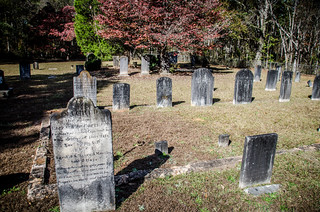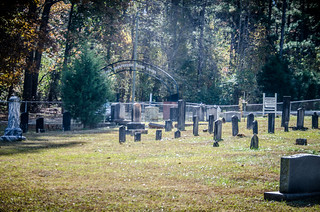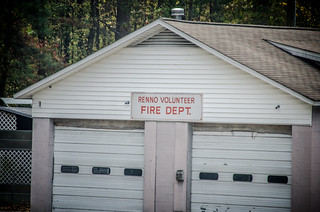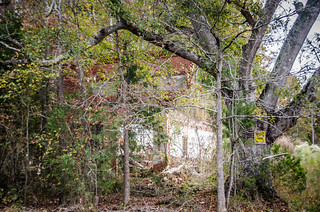
For November I wanted to make a major push on my book so that I could get early drafts submitted to publishers. That means spending lots of time in libraries and calling up lots of local historical societies to check some of my research. I’d made arrangements to meet with Elaine Martin in the genealogy section of the Laurens County Library. I wanted to find out some information about the ghost town of Renno and the surrounding Jacks Township. Since our appointment wasn’t until the afternoon, that gave me the morning to explore the area once again.
Jacks Township is one of nine townships established in Laurens County in its early history. The area is located on the far eastern corner of the county. Large portions of it are in the Sumter National Forest, and as I was growing up the area always seemed very remote and mysterious. Years later as an adult that impression has not changed. That little wedge, including parts of Newberry and Union Counties, strikes me as a place where tales of imagination are born.

from The Laurens County Scrapbook
My first stop on the trek was Duncan’s Creek Presbyterian Church. Organized in 1752, Duncan’s Creek is the oldest church in the county, and this area marks some of the earliest settlements in the region. It’s on the National Register of Historic Places, and its cemetery contains graves going back as far as 1776. The church itself is not far off of I-26. Fellow explorer Mark Elbrecht had stopped by a couple of years ago, but I had just never taken the time to stop by.
When I arrived the gates were open, and two trucks were parked in front of the church. I figured they wouldn’t mind if I came on in to explore, so I pulled in and began wandering among the headstones.
There were some very old graves in the cemetery. I didn’t see any signature stones, but there were quite a few stones with the hipped shoulders and some classic funerary art, including weeping willows, pointing fingers, and other motifs. There were also some simple old field stones. Many of the family names matched those of local landmarks. There were lots of Jacks, for whom the township was named, a few Philsons, and lots of Adairs. I didn’t see any I recognized as related to our family.
The two men were taking a walk around the church, surveying various items. One was in an electrical contractor truck, and the other obviously was a church official. I waved to let them know I meant no harm, and when it looked like their discussions were at an end, I headed over to introduce myself. The church official was Phil Adair, an elder. He was more than willing to give me a tour and a bit of history.
The current church was built in 1843. It originally had a small slave gallery/loft under the large front window. Phil showed me the outline of an old side door which had been bricked up, which allowed slaves to access the loft without disturbing the rest of the congregation.
Around back was the outline of an old window that had likewise been rebuilt. The stone archway was a dead giveaway.
Phil was kind enough to let me take a look inside. The design was simple, typical of the meeting houses of that time. And “meeting houses” they were – the church served not only for worship, but as a general gathering spot for area residents. The wooden pews were now padded, but were of simple construction. Phil said that there seemed to be four different styles of pews, possibly related to different time periods.
I was trying to figure out how they would have fit a slave loft into the church. I guess there had to have been a way. At the front of the church the pulpit area was flanked by two Revolutionary War memorials. There was a modern piano and small organ, and antique versions of those off to the side.
Phil told me that the church is still used for regular Sunday morning worship. Next fall they will be celebrating their 250th anniversary. They are embarking on a plan for restoration and major maintenance in preparation for that date. He had me sign their register so that I could get an invitation to the event.
As it turns out Phil’s family was one of the founding groups for the town of Renno. As we chatted he gave me some interesting insight into how the end of World War I hastened the decline of agricultural production in the state. The state was in depression before the official start date of 1929 for the rest of the country, and that’s what led to the town’s demise.
I thanked Phil for his time and the tour of the building, then headed out for Renno. I had noticed that between visits I made in 2008 and 2011 any remains had fallen further into ruin. I wanted to see if there was ANY remnant of those old brick ruins left.
Even though the town itself is a ghost town, there are some remnants. The name itself remains. Renno was once known as “Reynosa” until 1891, when the new post office was given the name “Renno”. There is still an active GNIS listing for the area, and there is even a Renno Fire Department. Across from the fire department is the old Tip Top store on Highway 72.
I found that nothing had really changed since my 2011 visit. Mobile homes flank the foundations and steps of the old Renno School.
The old Bell’s Store has two walls still standing.
Some of the old farm homes are undergoing renovations, but many are starting to deteriorate. One of the most impressive homes belonged to a Dr. Weir in the late 1800’s. That home now sits abandoned. It was very tempting to get out and explore. Some of the other homes were equally intriguing.
Although the railroad is still in use and is in good condition, any sign of a railroad depot is long gone. Across the tracks is a large farm that hearkens back to the original name of the town – Reynosa Ranch.
From Renno I headed back to Highway 72. I made a brief detour at the site of the old Sardis Methodist Church. The church was founded about the same time that Renno was established. It no longer exists, but the cemetery remains. In front of the cemetery was an open field area where the church must have once stood. The cemetery contained a couple of more recent headstones, as late as 1972.
From Sardis I turned onto Stomp Springs Road to check out the old springs. The area was just as scary and dilapidated as I remembered. Not long after Mark Elbrecht’s trek down this way there were news reports of a meth lab on the circle near the springs. Taking a page from Breaking Bad, the lab had been set up in an old RV. This is not the sort of place to hang about by yourself.
One thing I hadn’t realized was that the resort around the springs was relatively recent. Most springs-related resorts (Chick Springs in Taylors and Glenn Springs in Spartanburg County, for example) were in operation in the 1920s. Stomp Springs had its heyday in the late 1940s-1950s, and never really got going.
From Stomp Springs I made a brief stop at the old Riser Brick House at the intersection of Highway 66 and Stomp Springs Road. The old house is abandoned, but once served as a stage coach stop. It was said that Jefferson Davis once spent a night here. It’s sad to see it left to deteriorate.
I took Highway 66 westward toward Joanna. This is frankly a depressing little town, with boarded up storefronts and a textile mill left to collapse. The route from Joanna to Clinton along Highway 76 doesn’t fare much better.
In town I drove around the small square. It’s interesting to note that my great-great-great grandfather William Taylor, Jr. had a 150 acre land grant on this very spot. His land would have included the town square. I had lunch at The Steamer on the square, at what would have been the southwest corner of his property.
From Clinton I headed on into Laurens for my appointment with Elaine Martin. It turns out that her maiden name was “Jacks” and that she was from Renno. She was a wealth of information about the area, and I was impressed with the resources available at the Laurens County Library. I spent several hours there poring over old magazines and documents. I was also able to re-connect with Joey Holmes, who works at the library. Joey and I spent many days paddling the Enoree River and hiking various streams and paths in the area. His older brother, Jeff, was in my class, and Jeff and I played together in bands throughout high school and Furman.
In all, it was a great day of exploring and research. I met some fine folks, and learned lots of new things about the county in which I grew up. I’m definitely going to have to make another trip to the library. What this also pointed out, though, is that if I’m going to complete this book to my satisfaction, I’m going to have to make many more similar trips to libraries throughout the state. Each one has information specific to their locales. It’s not online, and a physical visit is the only way to view it. I guess I better set some dates and hit the road!















































Thank you so much for this!!
Deborah,
My mother was a Wier who’s family owned the old Wier place in your photo. My mother was born in Renno and I was born in Clinton in 1943. My mother’s father was a Wier, (Duh!) and her mother, my grandmother, was a Ray. Well the Ray side of the family is descended from a Jacks (as well as Simpsons, Rays, Prathers, Adairs, Braddocks, just some in that line, I am told.) These families date back to the Revolution. As for me, I am the 5th generation to be born within 5 miles of Duncan’s Creek Presbyterian Church, and a 7th generation South Carolinian. If you need more information email me. I currently live in Orangeburg, SC.
Steve K.
If you’d like, I can send you an typed transcript of an old oral history of the Riser house. A local librarian sent it to me.
Bruce, that would be fantastic! I’ll send you and e-mail so you can reply. Thanks!
Hi, I just started my genealogy research on ancestry.com and found out that my great great grandfather is listed as school master in the 1860 Reynosa census. His name was John Odell. I couldn’t find any mention of Reynosa anywhere on the web until I did a search for “reynosa jacks township south carolina” and found your page! So glad I did! Wonder if he taught at the school in your pictures. Do you know when that school dates back to? Feel free to email me.
I was interested in your post. My Dad (1917-2015) was born in Laurens, but he was orphaned and raised in the north by 1922. His Dad, Clarence Arthur O’Dell (1861-1922), was a harness maker and then shop keeper in Laurens. There is sketchy info through ancestry.com that c. 1870 O’Dells may have lived in Jacks Twp. Clarence, Sr., (d. 1877?) and Thomas O’Dell were the names we came across, but also John O’Dell which we aren’t sure is really related to us. My wife and I are visited Laurens 6/12/17 – 6/17. Any info you have that might be of interest to us I’d like to have and I’d be glad to share anything I have that might be of use to you.
My grandfather Clarence Arthur O’Dell (1861-1922) lived in Laurens, 323 Silver St.,most of his adult life. He was a harness maker and later a store keeper on Harper St. There is some sketchy info on ancestry that his father, also Clarence, may have lived in Jacks c. 1870. There may have also been a Thomas O’Dell in the family before the Clarences. My wife and I are visiting the area June 12-17 to look into family history. Any suggestions os resources we should search when we are there. I already know of the LC Museum and Public Lib. genealogy room. Thanks, 520-609-1525 (cell)
My family was from jacks her name was Hannah weir.
You should have went to Lower Duncan Creek gave yard. It is off Hwy 66 before you get to Whitmire SC. My GGG grandfather is buried there. His name was William Richey Neighbors. My family was from the Jacks area.
Hello my name is Micheal Andrew Jacks! My grandfather is Johnny Derl Jacks, and my great grandfathers name was Homer Derl Jacks! Im 33 yrs old, and i live in Joanna! Would love to learn more about the Jacks Township! This is all new information to me!